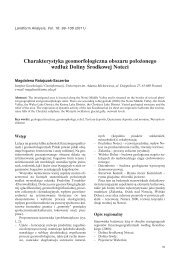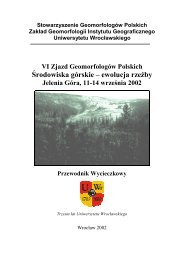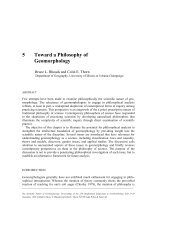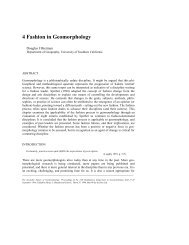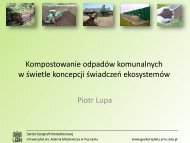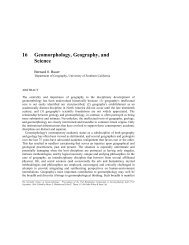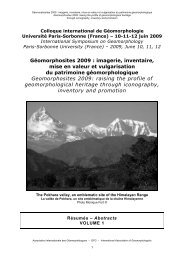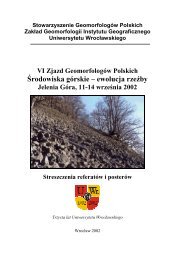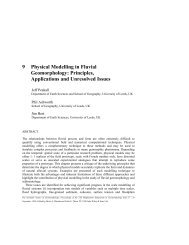Chapter 16 - Geomorphology, Geography, and Science Bernard 0
Chapter 16 - Geomorphology, Geography, and Science Bernard 0
Chapter 16 - Geomorphology, Geography, and Science Bernard 0
You also want an ePaper? Increase the reach of your titles
YUMPU automatically turns print PDFs into web optimized ePapers that Google loves.
GEOMORPHOLOGY, GEOGRAPHY, AND SCIENCE 383<br />
ficial, <strong>and</strong> logically nondefensible assertions strengthened by hegemonic posturing. They<br />
generally fail to appreciate that disciplines are human institutions that have evolved as<br />
convenience structures, <strong>and</strong> that their intellectual, methodological, theoretical, <strong>and</strong><br />
practical character <strong>and</strong> concerns are often inextricably intertwined. Furthermore,<br />
viewpoints are often divergent, egos are large, consensus is unlikely, <strong>and</strong> there is no<br />
absolute truth or authority to which one can turn for arbitration or resolution. A<br />
'Championship of the Disciplines' may be good sport, but its deeper purpose is far from<br />
clear.<br />
In view of these difficulties, this chapter will not follow a conventional tack that<br />
updates the comprehensive works of others who have assessed the important contributions<br />
of geographers to geomorphology through inventories of publications, citations, or society<br />
memberships (e.g. Graf et al. 1980; Costa <strong>and</strong> Graf 1984; Graf 1984; Marston 1989).<br />
Neither will it assert that a particular geomorphic principle, law, theory, or method has a<br />
distinct <strong>and</strong> uniquely geographical origin - this might be the case, but the supporting<br />
arguments would be hard to make. The reader is referred to any of several comprehensive<br />
histories of geography <strong>and</strong> geomorphology to search out such truths (e.g. Hartshorne<br />
1939; Chorley et al. 1964, 1973; Dury 1983; Tinkler 1985; Beckinsale <strong>and</strong> Chorley 1991;<br />
Unwin 1992; James <strong>and</strong> Martin 1978; Walker <strong>and</strong> Grabau 1993). Instead, the chapter will<br />
argue that:<br />
1. The intellectual <strong>and</strong> academic roots of geomorphology, geography, <strong>and</strong> geology are<br />
inextricably interwoven, <strong>and</strong> that it is therefore inappropriate <strong>and</strong> misleading to<br />
characterize key historical figures <strong>and</strong> events as exclusively 'geographic' or 'geologic' or<br />
to suggest that they were seminal in the evolution of geomorphology;<br />
2. <strong>Geomorphology</strong> has evolved into an academic subdiscipline, despite its long-st<strong>and</strong>ing<br />
intellectual tradition, <strong>and</strong> has become practically dependent on its host disciplines<br />
(primarily geography <strong>and</strong> geology) for academic survival;<br />
3. <strong>Geomorphology</strong> has benefited <strong>and</strong> will continue to benefit intellectually from the<br />
breadth <strong>and</strong> diversity that geography embraces <strong>and</strong> fosters;<br />
4. <strong>Geomorphology</strong>'s 'scientific' stance may be difficult to substantiate, <strong>and</strong> such posturing<br />
may not readily admit alternative perspectives of practical <strong>and</strong> intellectual utility to the<br />
discipline.<br />
These conditions have profound implications for the future evolution of geomorphology<br />
since they lead to the conclusion that geomorphology st<strong>and</strong>s to benefit from a strategy that<br />
advocates integration rather than separation. This is true with respect to both its<br />
interdisciplinary associations <strong>and</strong> its fundamental concerns with scale. The bulk of the<br />
chapter is devoted to providing the necessary background leading to this assessment.<br />
A CARICATURE OF GEOGRAPHY<br />
Throughout the history of geography, its practitioners have been variously perceived as<br />
very scientific, pseudoscientific, or antiscientific. The range of divergent viewpoints about<br />
geography's nature <strong>and</strong> utility are epitomized by the following quotes:<br />
<strong>Geography</strong> is queen of the sciences, parent to chemistry, geology, physics, <strong>and</strong> biology, parent<br />
also to history <strong>and</strong> economics. Without a clear grounding in the known characteristics of the



